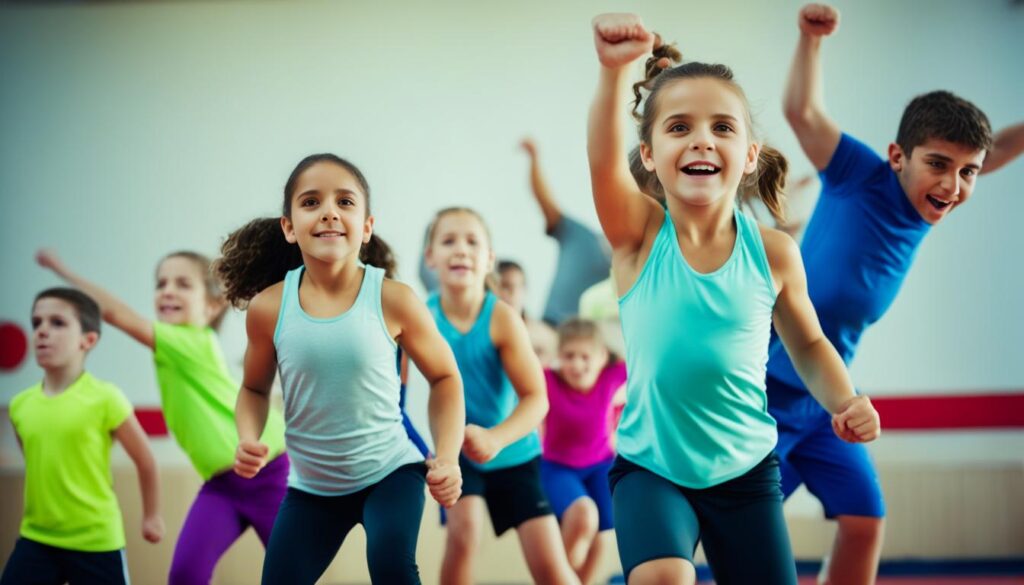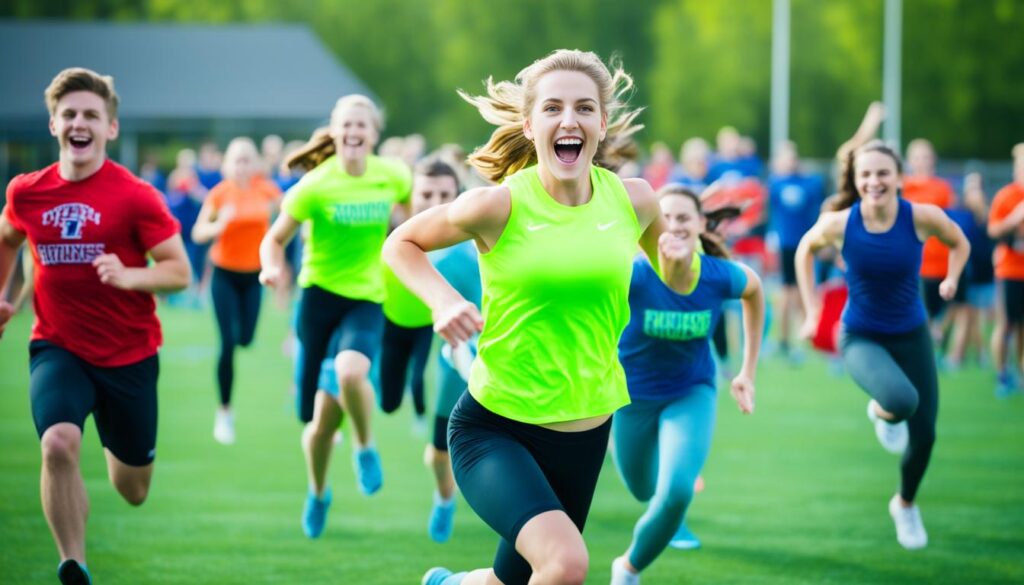Effective Physical Education Workouts for Schools
As a parent, I often find myself concerned about the well-being of my children. I want them to grow up strong, confident, and healthy. But in today’s world of technology and virtual learning, it’s becoming increasingly challenging to ensure that they get enough physical activity in their daily lives.
That’s why I’ve come to appreciate the importance of physical education workouts. These engaging and energizing exercises not only keep children active but also help improve their focus, mental health, and overall well-being. Physical education workouts are a valuable opportunity for children to experience the joy of movement and discover their physical abilities.
I remember when my daughter came home from school one day, bubbling with excitement about the fun exercises they did in physical education class. She couldn’t stop talking about the exhilaration she felt while playing games and participating in team activities. It was as if a newfound love for fitness had been ignited within her.
That experience made me realize the immense impact that physical education workouts can have on a child’s development. It’s not just about promoting physical health but also cultivating important life skills such as teamwork, discipline, and perseverance.
If you’re looking for ways to incorporate physical education workouts into your child’s routine, this article is here to help. We will explore a wide range of exercises and activities suitable for different ages and settings, whether in school or at home. From simple brain boosters to exciting group fitness games, there’s something for everyone.
Key Takeaways:
- Physical education workouts are essential for children’s overall well-being and development.
- These workouts improve focus, mental health, and physical fitness.
- Experiencing the joy of movement and discovering physical abilities is vital for children.
- Physical education workouts promote teamwork, discipline, and perseverance.
- This article provides a variety of exercises and activities suitable for different ages and settings.
Importance of Physical Education in Schools.
Physical education is a crucial component of a student’s overall development. It goes beyond traditional academics and focuses on promoting physical fitness, mental well-being, and academic achievement. Engaging in fitness activities for students not only helps build strong bones and muscles but also enhances concentration and memory, which positively impacts learning and academic performance.
Research has shown that students who participate in regular physical education have higher test scores in reading and improved cognitive function. Physical education lesson plans designed for elementary, middle, and high school students not only emphasize physical fitness but also promote skills such as teamwork, communication, and sportsmanship.
However, the time allocated for physical education varies across states and schools. Some educational institutions have reduced physical education and recess time to prioritize academic subjects. Advocating for quality physical education programs is essential to ensure that students receive adequate opportunities to develop their physical and mental well-being.
“Physical fitness is not only one of the most important keys to a healthy body, but it is also the basis of dynamic and creative intellectual activity.” – John F. Kennedy
Certified physical education teachers play a vital role in delivering comprehensive physical education. They create high school PE workouts, elementary school PE activities, and physical education lesson plans that align with the educational goals and needs of each age group.
According to guidelines, elementary students should engage in a minimum of 150 minutes per week of physical education, while middle and high school students should participate in at least 225 minutes per week. These guidelines ensure that students receive the necessary physical activity for their development and well-being.
By prioritizing fitness activities for students, schools can contribute to their overall health and academic success. Incorporating structured physical education programs allows students to develop lifelong healthy habits, increase their confidence, and promote positive mental health.
Benefits of Physical Education in Schools:
- Builds strong bones and muscles
- Promotes positive mental health
- Improves concentration and memory
- Fosters academic achievement
- Enhances cognitive function
- Develops teamwork and sportsmanship skills
Physical education is not just a break from academic subjects; it is a vital component of a well-rounded education. By investing in physical education programs, schools can create an environment that nurtures students’ physical and mental well-being while setting them on a path to lifelong health and success.
Youth Physical Fitness Programs in Schools.
Youth physical fitness programs are an integral part of promoting physical activity and instilling healthy habits among students. These programs aim to enhance children’s motor skills, sportsmanship, knowledge, and emotional intelligence, while also improving academic performance and focus. By incorporating these programs into school curricula, educators can foster a lifelong love for physical activity among students.
Some well-known youth fitness programs that schools can implement include:
- Presidential Youth Fitness Program: This nationally recognized program provides resources and tools for schools to assess and improve students’ overall fitness levels. It offers a comprehensive approach to physical fitness, including cardiovascular exercises for kids and strength training for teenagers.
- Kids Heart Challenge: Formerly known as Jump Rope for Heart, this program focuses on cardiovascular health and encourages kids to engage in group fitness games. It combines physical activity with fundraising to support the American Heart Association’s mission of building healthier lives.
- SHAPE America: SHAPE America offers a variety of resources and programs for physical educators to enhance their curriculum. Their resources include lesson plans, professional development opportunities, and guidelines for implementing engaging and effective fitness activities.
- National Bike to School Day: This annual event encourages students to bike or walk to school, promoting physical activity and reducing carbon emissions. Schools can organize group rides, bike safety lessons, and other activities to make the day memorable and exciting for students.
Implementing these youth physical fitness programs can be a powerful way to create an inclusive and engaging physical education environment that supports students’ overall well-being.
Engaging students in physical fitness programs not only improves their health but also bolsters their confidence and social skills. By participating in group fitness games and strength training, students can develop essential life skills and lay the foundation for a healthy lifestyle.
Physical Education Activities for Students.
Engaging students in high-quality physical education activities is crucial for promoting physical activity and overall fitness. These activities should be fun, age-appropriate, and designed to improve students’ gross motor skills. Here are some suggested activities that can be incorporated into physical education lessons:
- Scavenger Hunts: Encourage students to explore their surroundings while engaging in physical activity. Create a list of items or clues for students to find, incorporating movements such as running, jumping, and stretching.
- Dance Parties: Get students moving and grooving with dance parties. Play energetic music and teach simple dance routines or freestyle sessions to improve coordination and cardiovascular endurance.
- Crazy 8s: This game involves eight stations, each with a different physical activity. Students rotate through the stations, spending a designated amount of time at each one. Activities can include jumping jacks, push-ups, hopping, and balancing exercises.
- Getting to Know You Games: Foster team-building and social interaction through fun icebreaker activities. Encourage students to learn each other’s names while participating in physical challenges such as relay races or partner exercises.
- Walking Challenges: Setting walking challenges can motivate students to increase their daily steps. Create a friendly competition by tracking steps collectively or individually using pedometers or smartphone apps.
- Stretch Sessions: Dedicate time to performing stretching exercises to improve flexibility and prevent injuries. Teach students various stretches for different muscle groups, emphasizing the importance of proper form and breathing.
These activities can be adapted to suit different age groups and settings, including virtual learning environments. It is essential to provide options and modifications for students with different abilities, ensuring inclusivity and participation. Encouraging parental involvement can also support physical activity at home. To enhance the overall experience of physical education, consider incorporating music, community-building activities, and providing opportunities for student-led initiatives.
Fitness and Skill Tests in Physical Education.
Fitness and skill tests are valuable tools in physical education for assessing students’ physical fitness and tracking their progress over time. These tests allow educators to measure various aspects of physical fitness, including speed, strength, endurance, and flexibility. By incorporating these tests into physical education programs, teachers can help students set goals and improve their overall fitness levels.
Some commonly used fitness and skill tests in physical education include:
- The 40-yard dash: Measures speed and acceleration.
- Pull-ups: Tests upper-body strength and muscular endurance.
- Push-ups: Evaluates upper-body strength and muscular endurance.
- Sit-ups: Assesses abdominal strength and endurance.
- Wall sit test: Measures lower-body strength and endurance.
These tests provide valuable data that can guide physical education instruction and help students understand their individual fitness levels. By analyzing the results, teachers can provide specific feedback and support to students, fostering a positive and inclusive environment in physical education.
“Fitness and skill tests help students set goals and improve their overall fitness levels.”
To showcase the impact of fitness and skill tests, let’s take a look at the progress of a student named Emily over a school year:
| Test | Initial Score | Final Score | Progress |
|---|---|---|---|
| 40-yard dash | 8.2 seconds | 7.6 seconds | + |
| Pull-ups | 3 | 5 | ++ |
| Push-ups | 12 | 18 | ++ |
| Sit-ups | 30 | 35 | + |
| Wall sit test | 50 seconds | 1 minute | + |
This table clearly illustrates Emily’s progress in different fitness areas over the course of a school year. The improvements she has made in speed, upper-body strength, and endurance are significant. Such assessments not only motivate students but also help them understand the importance of regular exercise and the benefits it brings to their overall health and fitness.
Implementing fitness and skill tests in physical education contributes to the development of lifelong healthy habits and gives students an opportunity to take ownership of their well-being.

Physical Education Resources and Programs.
When it comes to supporting physical education in schools, there are a variety of resources and programs available. These resources can assist teachers in creating engaging and effective lesson plans, while also providing opportunities for professional development and access to proven classroom-tested activities.
PE Central
PE Central is a valuable website that offers a wide range of resources for physical education teachers. One of the highlights of this platform is its collection of lesson plans, which provide a structured framework for educators to deliver engaging physical education activities. Additionally, PE Central offers professional development opportunities, allowing teachers to stay updated on the latest trends and best practices in the field. With its real classroom-tested activities, PE Central serves as a trusted resource for teachers seeking to enhance their physical education programs.
Youth Physical Activity Guidelines Toolkit
The Youth Physical Activity Guidelines Toolkit, provided by the CDC, serves as a comprehensive resource for promoting regular physical activity in schools, families, and communities. This toolkit offers a wealth of ideas and resources that can be implemented to encourage students to engage in healthy and active lifestyles. By incorporating these guidelines into their physical education programs, teachers can help students develop lifelong habits of physical activity.
SHAPE America and the American Heart Association
SHAPE America and the American Heart Association are two well-known organizations that provide guidance and materials for physical educators. These resources cover a wide range of topics, including curriculum development, assessment strategies, and the promotion of physical activity. By accessing these resources, teachers can gain valuable insights and practical tools to deliver high-quality physical education programs.
Incorporating these resources and programs into physical education curricula can significantly enhance the overall quality of instruction. By utilizing proven lesson plans, accessing professional development opportunities, and implementing evidence-based strategies, teachers can create engaging and effective physical education experiences for their students.
| Resource | Description |
|---|---|
| PE Central | A website offering lesson plans, professional development, and classroom-tested activities. |
| Youth Physical Activity Guidelines Toolkit | A comprehensive resource provided by the CDC to promote regular physical activity in schools, families, and communities. |
| SHAPE America | An organization providing guidance and materials for physical educators. |
| American Heart Association | An organization offering resources and support for physical education programs. |
Field Day Games and Activities.
Field days are an exciting opportunity for students to engage in a variety of physical education activities. These events not only promote physical fitness but also foster teamwork and inclusivity. In this section, I will share some fun and engaging games and activities that you can incorporate into your field day event.
Note: Planning ahead, seeking help from other teachers or parents, and ensuring you have an adequate supply of materials are key factors in organizing a successful field day.
Virtual Rock Wall Obstacles
One innovative idea for a field day activity is setting up virtual rock wall obstacles using a projector. This activity provides a unique challenge for students and can be adjusted to cater to different skill levels. By projecting a rock wall onto a flat surface, students can experience the thrill of climbing and challenge their physical abilities.
Cooperative Fitness Challenges
Incorporating cooperative fitness challenges into your field day activities is a great way to encourage teamwork among students. These challenges can include activities like tug-of-war, relay races, or obstacle courses where students must work together to achieve a common goal. Through collaboration and communication, students can enhance their physical abilities while building strong bonds with their peers.
Fitness Bingo
Another engaging activity for field day is Fitness Bingo. Create a bingo card with different fitness activities listed in each square, such as jumping jacks, push-ups, or high knees. Students can then participate in these activities and mark them off on their bingo card as they complete each one. The first student to complete a row or column can call out “Bingo!” and be declared the winner.
Various Outdoor Games
Field day wouldn’t be complete without a range of traditional outdoor games. Include classics like sack races, three-legged races, and water balloon tosses to add a nostalgic touch to the event. These games are not only fun but also help students improve their coordination, balance, and overall physical fitness.
To summarize, field day games and activities provide an excellent opportunity for students to engage in physical education activities while promoting teamwork and inclusivity. Consider incorporating virtual rock wall obstacles, cooperative fitness challenges, fitness bingo, and various outdoor games to create a memorable and enjoyable field day experience for all students.

| Activity | Objective |
|---|---|
| Virtual Rock Wall Obstacles | To challenge students’ physical abilities and provide a unique climbing experience. |
| Cooperative Fitness Challenges | To promote teamwork and collaboration among students through physical activities. |
| Fitness Bingo | To make physical fitness engaging and enjoyable for students through a bingo-style game. |
| Various Outdoor Games | To provide a range of classic outdoor games that enhance students’ physical abilities and coordination. |
Importance of Physical Education in Child Development.
Physical education plays a crucial role in the holistic development of children. Engaging in regular physical activity promotes physical health, mental well-being, social skills, and emotional intelligence. It can also enhance cognitive function, attention, and academic achievement. By teaching children about the importance of physical health and providing opportunities for physical activity, schools can contribute to the overall development and well-being of their students. Physical education should be recognized as an essential subject and given equal importance to other academic subjects.
Physical education exercises and fitness activities for students are not only beneficial for their physical well-being but also for their mental and social development. Regular exercise helps children build strong bones and muscles, improve cardiovascular health, and maintain a healthy weight. It also releases endorphins, which can elevate mood and reduce stress and anxiety.
In addition to the physical benefits, physical education activities promote social skills and teamwork. Through group fitness games and sports, students learn to collaborate, communicate, and problem-solve. They develop important skills such as leadership, sportsmanship, and resilience, which are essential for their personal and professional growth.
Moreover, physical education enhances cognitive function and academic performance. Research has shown that physical activity can improve attention, memory, and overall cognitive ability. By engaging in physical education exercises, students can develop better focus and concentration, leading to improved academic achievement.
“Physical education is not only about exercise; it is about empowering students with the knowledge and skills to lead a healthy and active lifestyle. It sets a foundation for lifelong physical activity and contributes to the overall well-being and success of individuals.”
To emphasize the importance of physical education in child development, schools should prioritize the inclusion of structured physical education programs in their curriculum. By providing dedicated time for physical education, schools can ensure that students engage in a variety of fitness activities and develop a lifelong love for exercise and movement.
The Benefits of Physical Education in Child Development
Physical education offers a wide range of benefits for children’s development:
- Promotes physical health and well-being
- Enhances mental well-being and reduces stress
- Improves social skills and teamwork
- Develops emotional intelligence and resilience
- Enhances cognitive function and academic performance
By recognizing the significance of physical education exercises, fitness activities for students, and the overall benefits of physical education, schools can create an environment that fosters the growth and development of well-rounded individuals.
Barriers to Quality Physical Education.
Implementing effective physical education (PE) programs in schools can be challenging due to several barriers that hinder their success. These barriers often prevent students from accessing quality physical education, impacting their overall health and wellbeing. In this section, we will explore some of the common challenges and barriers faced in implementing physical education programs.
Limited Time Allocation for Physical Education
One significant barrier to quality physical education is the limited time allocated for PE in schools. With the increasing emphasis on academic subjects, physical education often takes a backseat, resulting in reduced class time for physical activity. Schools may face pressure to allocate more time to core subjects, leaving little room for PE.
Lack of Resources and Facilities
Another barrier to PE is the lack of resources and facilities. Many schools struggle to provide adequate equipment, space, and qualified instructors for physical education classes. This limitation hampers the implementation of comprehensive and engaging PE programs that can cater to the diverse needs of students.
Emphasis on Academic Subjects
The strong emphasis on academic subjects, driven by standardized testing and achievement-based metrics, often leads schools to prioritize academic subjects over physical education. This shift in focus can result in reduced time, funding, and support for PE, making it challenging to deliver quality physical education programs.
Waivers and Exemptions
Some schools offer waivers or exemptions that allow students to opt-out of participating in physical education. While these waivers may be intended to accommodate individual circumstances, they can contribute to a decline in overall participation rates in PE classes. This lack of mandatory participation undermines the importance of physical education in fostering lifelong healthy habits among students.
The Impact of No Child Left Behind Act
The No Child Left Behind Act, introduced in 2001, has inadvertently resulted in significant cuts to physical education and recess time in some schools. The act’s focus on standardized testing and academic performance has led to reduced physical activity opportunities, negatively impacting students’ health and well-being.
Addressing the Barriers
To overcome these barriers, it is crucial to prioritize physical education and advocate for its importance in schools. Efforts should be made to allocate sufficient time and resources for physical education, ensuring that all students have equal access to quality PE programs. Policy changes, such as mandating minimum PE requirements and advocating for adequate funding, can help address these barriers. Additionally, schools can promote the integration of physical activity into other subjects, creating a holistic learning experience that emphasizes the significance of maintaining a healthy lifestyle.
Solutions for Overcoming Barriers to Physical Education.
Improving physical education and finding solutions for PE challenges requires a comprehensive and collaborative approach. By addressing barriers and implementing strategies, schools can create a positive and inclusive environment that prioritizes physical activity. Here are some key solutions:
1. Allocating Sufficient Time and Resources
Schools must prioritize physical education by allocating adequate time within the curriculum and providing necessary resources for effective physical activity. This includes dedicated class periods, access to sports equipment, and qualified physical education teachers.
2. Collaboration Between Educators, Administrators, and Parents
Advocacy plays a vital role in overcoming barriers to physical education. Teachers, administrators, and parents should collaborate to advocate for the importance of physical education in schools. This includes raising awareness, attending meetings, and engaging in open dialogues.
3. Incorporating Physical Activity into Other Subjects
Integrating physical activity into other subjects, such as incorporating movement breaks during classroom instruction, can help overcome time constraints and increase physical activity opportunities throughout the school day.
4. Creating Inclusive Environments
Schools should strive to create inclusive physical education environments that cater to students with diverse abilities and needs. This includes providing modified activities and equipment, promoting positive social interactions, and fostering a sense of belonging for all students.
5. Providing Professional Development Opportunities
Offering professional development opportunities for physical education teachers ensures they have the knowledge and skills to deliver high-quality programs. This can include workshops, conferences, online courses, and access to research-based resources.
6. Collecting Standardized Data for Monitoring and Policy Development
Collecting standardized data on physical education provision and participation allows schools to monitor progress and inform evidence-based policies. This data can help identify areas for improvement, allocate resources effectively, and track the impact of physical education programs.
By implementing these solutions, schools can overcome barriers to physical education, ultimately improving the overall quality and impact of physical education programs.
Conclusion.
Physical education plays a vital role in promoting the overall well-being of students. Through physical education, students have the opportunity to engage in health-enhancing activities, develop essential skills, and improve their academic performance. By prioritizing physical education, schools can create a positive and inclusive environment that fosters a lifelong love for physical activity.
It is crucial to overcome barriers and advocate for quality physical education programs to ensure that all students have access to the benefits of physical education. By providing the right resources and support, schools can transform physical education and make a significant impact on students’ overall well-being.
Let us recognize the importance of physical education and its potential to improve the physical, mental, and social health of students. By investing in physical education, we can empower our students to lead healthy and active lives, setting them up for success both inside and outside the classroom.
FAQ
What are some effective physical education workouts for schools?
Some effective physical education workouts for schools include cardiovascular exercises like running or jumping rope, strength training exercises using bodyweight or resistance bands, and flexibility exercises like yoga or stretching.
Why is physical education important in schools?
Physical education is important in schools because it promotes physical health, mental well-being, social skills, and cognitive function. It also contributes to academic achievement and helps instill lifelong healthy habits.
What are some youth physical fitness programs available in schools?
Some youth physical fitness programs available in schools include the Presidential Youth Fitness Program, Kids Heart Challenge, SHAPE America, and National Bike to School Day. These programs provide resources and guidelines to promote physical activity and healthy habits among students.
What are some physical education activities suitable for students?
Some physical education activities suitable for students include scavenger hunts, dance parties, group fitness games, walking challenges, and stretch sessions. These activities can be adapted for different age groups and settings, including virtual learning environments.
What are some fitness and skill tests used in physical education?
Some fitness and skill tests used in physical education include the 40-yard dash, pull-ups, push-ups, sit-ups, and wall sit test. These tests assess various aspects of physical fitness and can help students set goals and track their progress over time.
Where can I find physical education resources and programs for schools?
Physical education resources and programs for schools can be found on websites like PE Central, CDC’s Youth Physical Activity Guidelines Toolkit, SHAPE America, and the American Heart Association. These resources provide lesson plans, guidelines, and materials to support effective physical education programs.
What are some recommended field day games and activities for schools?
Some recommended field day games and activities for schools include virtual rock wall obstacles, cooperative fitness challenges, fitness bingo, and various outdoor games. These activities promote teamwork, inclusivity, and physical activity among students.
How does physical education contribute to child development?
Physical education contributes to child development by promoting physical health, enhancing mental well-being, improving social skills, and fostering emotional intelligence. It also enhances cognitive function, attention, and academic achievement.
What are the barriers to quality physical education in schools?
The barriers to quality physical education in schools include limited time allocated for physical education, lack of resources and facilities, emphasis on academic subjects, and waivers or exemptions that allow students to opt-out of physical education.
What are some solutions for overcoming barriers to physical education?
Some solutions for overcoming barriers to physical education include prioritizing physical education, allocating sufficient time and resources, advocating for its importance, incorporating physical activity into other subjects, creating inclusive environments, and providing professional development opportunities for teachers.
Why is physical education important for students?
Physical education is important for students because it promotes their physical health, mental well-being, social skills, and academic achievement. It helps build strong bones and muscles, improves concentration and memory, and fosters a lifelong love for physical activity.

















It's great that you talked about how business insurance can provide financial protection against unexpected events and help ensure the…
I like that you mentioned how business insurance is essential for protecting your bottom line and the long-term viability of…